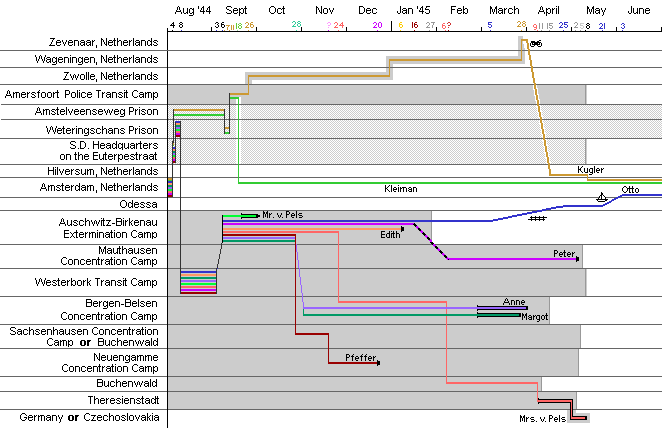
|
| |||||||||||||
|
Symbols
Here are some numbers of barracks and tatoos and some other details.
|
|
||||||||||||
|
After the Diary: Where They Were Taken Anne's diary ends on 1 August 1944. She did not write entries every day. On the 4th of August, the secret Annex was raided. Two of the helpers were taken away as well as everyone who was hiding in the secret annex. This graph maps out the places they were taken (etc.) with the dates. Of the people who had been in hiding, only Otto Frank survived the concentration camps. (All of the helpers survived, and the two who were taken away were not sent to concentration camps.) |

| |||||||||||||||||
| |||||||||||||||||
|
Locations of the camps Amersfoort Police Transit Camp was east of Amsterdam. see offsite map (http://www.cympm.com/map-holland.html) Westerbork Transit Camp was in the north eastern Netherlands. see offsite map (http://www.cympm.com/map-holland.html) Auschwitz-Birkenau Extermination Camp was in Poland (near Krakow). Mauthausen Concentration Camp was in Austria (near Linz). Bergen-Belsen was in Germany (near Hamburg). Sachsenhausen Concentration Camp was in Germany (near Berlin). Buchenwald was in central Germany. Neuengamme Concentration Camp was in Germany (near Hamburg). Theresienstadt was in north western Czechoslovakia (near the German border).
|
an original BBC radio report from Belsen's liberation on 15 April 1945 (link does not work in Firefox)
References:
Anne Frank: Beyond the Diary, a Photographic Remembrance, by Ruud van der Rol and Rian Verhoeven for the Anne Frank House, p. 12-13, 94-5.
Europe, Germany, and WWII maps, by National Geographic Magazine, 1992, 1991, and 1991.
Anne Frank: the Biography by Melissa Müller, p. 259.
Anne Frank Remembered, documentary.
Europe, Germany, and WWII maps, by National Geographic Magazine, 1992, 1991, and 1991.
The Hidden Life of Otto Frank has a good deal of information about the different people's deportations, especially Otto Frank's.
for Liberation Dates of the Camps:
http://www.usnews.com/usnews/news/freesurv.htm This page no longer exists.
http://www.us-israel.org/jsource/Holocaust/Chronology_1945.html
http://www.holocaustcenter.org/Holocaust/nazi1945.shtml
Map:
http://www.us-israel.org/jsource/Holocaust/libmap.html
The Avalon Project: Nuremberg Proceedings
http://www.yale.edu/lawweb/avalon/imt/proc/12-13-45.htm
(just info on where
some concentration camps were)
Last Update: 12 June 2004